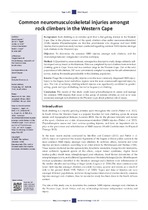Common neuromusculoskeletal injuries amongst rock climbers in the Western Cape
Date
2015Author
Wegner, Liezel
Pagel, Jarryd
Smit, Ashley
Straszacker, Aimee
Swart, Sarah
Taft, St John
Metadata
Show full item recordAbstract
BACKGROUND: Rock climbing is an extreme sport that is fast gaining interest in the Western Cape. Due to the physical nature of the sport, climbers often suffer neuromusculoskeletal (NMS) injuries. Physiotherapists are first-line practitioners who diagnose and treat NMS injuries, but no previous study has been conducted regarding common NMS injuries amongst rock climbers in the Western Cape.
OBJECTIVE: To determine the common NMS injuries amongst rock climbers, and the
relationships between independent variables and injury.
METHOD: A Quantitative, cross-sectional, retrospective descriptive study design utilised a self developed
survey based on the literature. This was completed by rock climbers from an indoor
climbing gym in Cape Town and two outdoor crags in the Western Cape. Out of the total
population of 650 climbers, 247 were conveniently sampled to complete the self-administered
SURVEY, making the results generalisable to the climbing population.
RESULTS: Finger flexor tendon pulley injuries were the most commonly diagnosed NMS injury.
Injury to the fingers, hand and elbow regions were the most common self-reported injury by
area. The risk of suffering climbing-related injuries was significantly correlated to gender,
setting, grade and type of climbing, but not to frequency of climbing.
CONCLUSION: The results of this study could assist physiotherapists to assess and manage the common NMS injuries that occur in this group of extreme athletes, as well as to raise awareness amongst rock climbers in the Western Cape about potential risk of injury.

